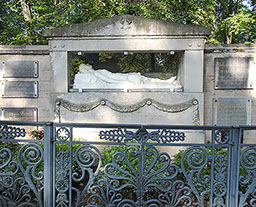In 1934, Richard Müller devoted himself to depicting the tomb of the Goethe family in the Old (now Historic) Cemetery in Weimar. He did so with great graphic sensitivity and a refinement that is reminiscent of his artistic role models, like Adolph von Menzel (1815-1905). This resting place has been preserved unchanged to the present (see photo), and has meanwhile become a major tourist attraction, despite the fact that the most famous family member – Johann Wolfgang von Goethe (1749-1832) – was not buried here. He received a place of honor, instead, in the central “princes‘ crypt” within the same cemetery. At Goethe‘s own request, he rests peacefully next to the sarcophagus of his friend Friedrich von Schiller (1759-1805). It was indeed a very special tribute on the part of the grand ducal family of Saxe-Weimar-Eisenach to include the mortal remains of these men, the country‘s two most important intellectual giants, in the princely family tomb. Nor was Christiane Vulpius (1765-1816), whom J.W. von Goethe was allowed to wed in 1806 after 18 years of unmarried domestic partnership, buried in the family tomb shown here. She was interred instead in the central burial grounds of St. Jacob‘s Church in Weimar, since the larger cemetery there was first established in 1818. Their son August, who tragically preceded his father in death in 1830 in Rome and lies in the so-called Protestant Cemetery of that city, is likewise missing from the group of Goethe‘s family members who found their final resting place in the tomb shown here.

